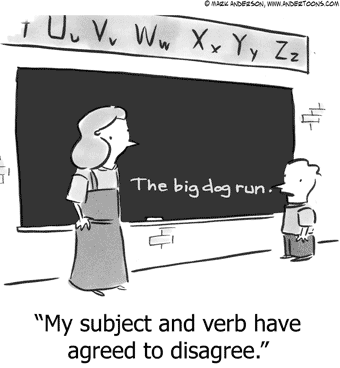Introduction

Source: “Agree to Disagree,” Mark Anderson, Andertoons
Unlike the boy in the cartoon, you don’t want your subjects and verbs to disagree. Most of the time, subject-verb agreement isn’t a problem because you recognize there’s something wrong with sentences such as “They says hello” or “Mary jump high.” Besides sounding awful, they’re grammatically incorrect because “They” is plural in number, while “says” is singular; “Mary” is singular in number, but “jump” is plural. The subjects and verbs obviously don’t agree.
Sometimes, however, when you’re editing more complex sentences, determining whether a subject and a verb match might be more difficult. For example, the verb may be evident, but which one of several nouns and pronouns in the sentence is the subject of the verb? And are the subject and the verb both singular or both plural?
You want your writing to be as error-free as possible, but figuring out subject-verb agreement quandaries can be confusing. That’s why this lesson will come in handy. We’re going to provide some tips about how to locate and correct agreement problems; then you will have a chance to practice your skills and feel more confident about writing sentences with subjects and verbs that agree.
Here’s the simple principle you need to remember as you edit for subject-verb agreement:
A subject and a verb must agree in number, which means a singular subject needs a singular verb, and a plural subject needs a plural verb.
With that in mind, let’s get started.